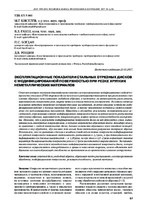Эксплуатационные показатели стальных отрезных дисков с модифицированной поверхностью при резке хрупких неметаллических материалов
Another Title
Performance characteristics of steel cutting discs with a modified surface for cutting brittle non-metallic materials
Bibliographic entry
Эксплуатационные показатели стальных отрезных дисков с модифицированной поверхностью при резке хрупких неметаллических материалов = Performance characteristics of steel cutting discs with a modified surface for cutting brittle non-metallic materials / М. Г. Киселев [и др.] // Механика машин, механизмов и материалов. - 2017. – № 2. – С. 57-64.
Abstract
Статья посвящена экспериментальной оценке влияния электроэрозионного модифицирования гладкой поверхности стального (У8А) отрезного диска на его эксплуатационные показатели при распиливании стеклянных образцов с использованием свободного абразива, в частности, на интенсивность распиливания, шероховатость поверхности реза, ширину пропила и износостойкость инструмента. Изложены основные положения методики проведения экспериментальных исследований, включая описание устройств модифицирования рабочей и боковых поверхностей диска, а также примененных методов и средств определения его эксплуатационных показателей. Приведены и обсуждены результаты экспериментальных исследований, отражающие влияние модифицирования поверхности диска на интенсивность распиливания стеклянных образцов, шероховатость поверхности реза, ширину пропила и износостойкость инструмента. Показано, что в результате модифицирования поверхности диска на ней образуются лунки, выполняющие роль своеобразных микрокарманов, в которых закрепляется абразивная паста.
Abstract in another language
The paper is devoted to the experimental estimation of the effect of electroerosive modification of the smooth surface of a steel (U8A) cutting disc on its operational parameters when cutting glass samples using free abrasive,in particular, on the intensity of sawing, the roughness of the cutting surface, the width of the cut and the wear resistance of the tool. The main provisions of the experimental research methodology are described, including a description of the devices for modifying the working and lateral surfaces of the disk, as well as the methods and means used to determine its operational parameters. The results of experimental studies reflecting the effect of modifying the surface of a disc on the intensity of sawing glass specimens, the roughness of the cutting surface, the width of the cut and the wear resistance of the tool are presented and discussed. It is shown that, as a result of modifying the surface of the disk, holes are formed on it, which serve as a kind of micro-folds in which an abrasive
paste is fixed. Due to this, in comparison with the smooth surface of the disc, a greater number of abrasive grains fall directly into the treatment zone, thereby causing more intensive destruction of the sample material. It is established that, in comparison with the disk in the initial (smooth) state of the surface, modifying its working surface raises the sawing intensity 1,1 times, and with additional modification of its lateral surfaces 1,25 times, but at the same time 1,5–2 times the value Ra of the roughness of the surface of the cut increases and the width of the cut increases
by a factor of 1,4. It has been experimentally shown that by periodically modifying the worn out surface of the disc, which is technically carried out directly during the operation, it is possible to maintain its high cutting ability throughout the entire time of use of the tool.

